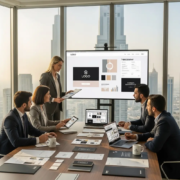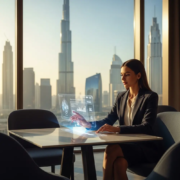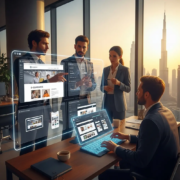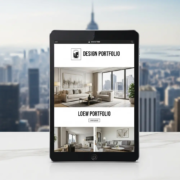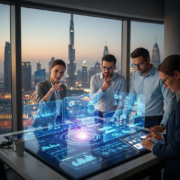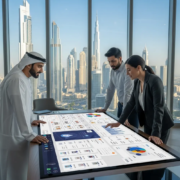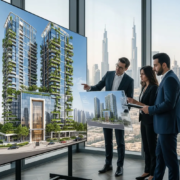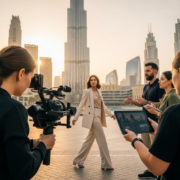Corporate Identity Packages for UAE Businesses.
Corporate Identity Packages for UAE Businesses: Your Blueprint for Success
In the dynamic and competitive landscape of the United Arab Emirates, establishing a strong, memorable presence is not just an advantage – it’s a necessity. From the soaring skylines of Dubai to the cultural heart of Abu Dhabi and the industrial vigor of Sharjah, businesses are constantly vying for attention. This is where Corporate Identity Packages for UAE Businesses become an indispensable tool. More than just a logo, a comprehensive corporate identity is the visual and emotional language your brand uses to communicate its values, mission, and personality to the world. It’s the consistent thread that weaves through every touchpoint, building recognition, fostering trust, and ultimately, driving growth in this vibrant economy. Understanding and investing in a robust corporate identity package is the first strategic step towards carving out a distinctive and prosperous niche in the UAE market.
What Exactly is a Corporate Identity Package?
At its core, a corporate identity package is a curated collection of all the visual and communicative elements that define a brand. It’s far more extensive than merely designing a logo; it’s about crafting a holistic representation that evokes a specific feeling and message. Think of it as the DNA of your business, ensuring every interaction with your brand is consistent, professional, and aligned with your core values. For businesses operating in bustling commercial hubs like Dubai, where first impressions are paramount, a well-defined corporate identity is crucial for standing out.
A typical corporate identity package encompasses a range of elements, starting with the foundational visual assets. This includes a distinctive logo, which serves as the ultimate symbol of your brand. Beyond that, it specifies a cohesive color palette, ensuring brand recognition across all platforms. Typography is another critical component, defining the fonts used in all communications to maintain a consistent tone. Imagery, graphic styles, and even photographic guidelines are often included to ensure visual harmony. Crucially, a corporate identity package also incorporates practical applications such as business stationery (letterheads, envelopes, business cards), marketing collateral (brochures, flyers), and digital assets (website design elements, social media templates, email signatures). Each component is meticulously designed to work in synergy, projecting a unified and professional image that resonates with diverse audiences across the UAE, from the cosmopolitan residents of Abu Dhabi to the industrious communities in Sharjah.
The Indispensable Value for UAE Businesses
In a market as diverse and rapidly evolving as the UAE, the value of a strong corporate identity package cannot be overstated. Businesses in Dubai, Abu Dhabi, and Sharjah face intense competition, and establishing a unique, memorable presence is key to long-term success. A well-crafted corporate identity provides several critical advantages that are particularly pertinent to the region’s commercial landscape.
Brand Recognition & Recall in a Competitive Market
One of the primary benefits is enhanced brand recognition. In a marketplace saturated with options, a consistent visual identity makes your business instantly recognizable. When potential clients repeatedly encounter your distinct logo, colors, and typography across various platforms – from a billboard in Downtown Dubai to an online ad targeting Abu Dhabi – your brand becomes ingrained in their memory. This familiarity fosters trust and makes your business the natural choice when their needs align with your services.
Credibility & Trust
A professional and coherent corporate identity signals reliability and competence. It tells customers that your business is established, takes itself seriously, and pays attention to detail. This perception of professionalism is vital for building trust, especially when dealing with high-value clients or international partners. In the UAE, where business relationships are often built on reputation and trustworthiness, a strong identity package lends significant credibility to your operations, distinguishing you from less polished competitors in Sharjah and beyond.
Differentiation from Competitors
Standing out in the UAE’s vibrant economy requires more than just offering excellent products or services; it demands a unique identity. A bespoke corporate identity package allows your business to articulate its unique selling propositions visually. It differentiates you from rivals, making your brand memorable for the right reasons. This distinctiveness helps you cut through the noise, attracting your target audience who resonate with your specific brand personality and values.
Internal Cohesion & Morale
Beyond external perceptions, a strong corporate identity fosters internal cohesion. When employees understand and embody the brand’s visual and ethical guidelines, it cultivates a sense of belonging and pride. This unified vision translates into a more cohesive team that collectively works towards common goals, projecting a consistent message to clients. This internal alignment is particularly beneficial for businesses with multiple branches or a large workforce spread across the emirates, such as those with offices in both Dubai and Abu Dhabi.
Market Positioning and Value Perception
Finally, a robust corporate identity package significantly influences how your business is perceived in the market. It can position your brand as a premium provider, an innovative disruptor, or a reliable, traditional service. This strategic positioning allows you to attract the right kind of customers and command appropriate pricing, reflecting the perceived value of your offerings. For any business aiming for sustained growth and influence in the UAE, investing in a professional corporate identity is a strategic imperative.
Key Components of a Comprehensive Corporate Identity Package
A truly effective corporate identity package is a multi-faceted creation, carefully designed to cover every touchpoint where your brand interacts with the world. For businesses striving for excellence in the UAE, each component plays a vital role in building a cohesive and impactful presence across Dubai, Abu Dhabi, and Sharjah.
Logo Design
The logo is arguably the most recognizable element of a corporate identity. It’s the visual anchor, a symbol that encapsulates your brand’s essence. A well-designed logo is simple, memorable, versatile, and appropriate for your industry. It should be easily reproducible across various mediums, from a small icon on a mobile screen to a large billboard. For professional branding services, the logo design process involves deep dives into brand strategy, competitive analysis, and creative exploration to ensure it perfectly represents your business.
Typography & Color Palette
Beyond the logo, the chosen fonts (typography) and color scheme are powerful communicators of brand personality. Specific fonts can evoke feelings of trust, modernity, elegance, or innovation. A defined color palette ensures consistency, helping to build brand recognition and associate specific emotions with your business. These guidelines dictate the use of colors and fonts across all materials, from your website to print advertisements, ensuring a harmonious visual experience.
Stationery & Marketing Collateral
These are the tangible elements that carry your brand’s identity into the physical world. This category typically includes:
- Business Cards: A crucial networking tool, reflecting professionalism.
- Letterheads & Envelopes: Essential for official communications, reinforcing credibility.
- Brochures & Flyers: Marketing materials designed with consistent branding to convey key messages.
- Company Folders: For presenting documents in a branded, organized manner.
- Social Media Templates: Ensuring a consistent visual voice across digital platforms.
Having a unified design across these items projects an image of meticulous attention to detail and professionalism, which is highly valued in the UAE business environment.
Brand Guidelines Manual
Often referred to as a “brand book,” this comprehensive document is the bible of your corporate identity. It meticulously outlines the rules for using all brand elements. It covers logo usage (including minimum size, clear space, and incorrect applications), color specifications (CMYK, RGB, HEX, Pantone), typography hierarchy, imagery style, tone of voice, and even guidelines for internal communications. This manual is indispensable for maintaining brand consistency, especially as your business grows or works with external vendors, ensuring that every piece of communication adheres to the established identity. An expert design team can craft a thorough brand guideline manual that is easy to understand and implement.
Digital Assets
In today’s digital-first world, a corporate identity package must include guidelines and assets for online presence. This covers elements such as website design templates, social media profile images and cover photos, email signatures, banner ad designs, and presentation templates. Ensuring a consistent brand experience across digital platforms is critical for engaging modern audiences in the UAE and for maximizing your digital marketing strategies.
By encompassing all these elements, a well-executed corporate identity package provides a robust framework for any business, enabling them to present a unified, professional, and memorable image that resonates powerfully in the competitive UAE market. Artsun advertising agency excels in crafting these comprehensive packages, tailored to the unique needs of local and international businesses.
Tailoring Your Corporate Identity for the UAE Market
The UAE is a melting pot of cultures, a global economic hub, and a market with its own unique nuances. Developing Corporate Identity Packages for UAE Businesses requires more than just good design; it demands a deep understanding of local context, cultural sensitivities, and market dynamics. Successfully navigating this environment means tailoring your brand’s identity to resonate authentically with both local and international audiences.
Cultural Sensitivity and Localization
One of the most crucial aspects is cultural sensitivity. The UAE is predominantly an Islamic nation, and its rich traditions and values must be respected. This translates into design choices – avoiding imagery or colors that might be considered offensive or inappropriate, and conversely, incorporating elements that signify respect and understanding. For example, the use of Arabic calligraphy or subtle patterns inspired by Islamic art can add a touch of local elegance. Language is also key; while English is widely spoken, having a brand identity that can seamlessly integrate Arabic (e.g., bilingual logos, marketing materials) demonstrates a commitment to the local audience in places like Abu Dhabi and Sharjah.
Market Dynamics: Innovation Meets Tradition
The UAE market is characterized by a fascinating blend of rapid innovation and deep-rooted tradition. Businesses in Dubai are often at the forefront of global trends, embracing cutting-edge technology and modern aesthetics. However, there’s also a strong appreciation for heritage and quality. A successful corporate identity will strike a balance, projecting a modern, forward-thinking image while subtly acknowledging and respecting the cultural bedrock of the region. This duality allows businesses to appeal to both the tech-savvy youth and the more traditionally inclined segments of the population.
Regulatory Compliance and Best Practices
Adhering to local regulations regarding advertising, intellectual property, and business conduct is paramount. Your corporate identity must be designed in a way that aligns with these legal frameworks. This includes ensuring trademark compliance for your logo and brand name, as well as considering any specific industry regulations. A local advertising agency like Artsun advertising agency understands these intricacies, helping businesses navigate the legal landscape while creating compelling brands.
Reaching a Diverse Audience
The UAE is home to expatriates from across the globe, creating a highly diverse consumer base. A corporate identity designed for the UAE market must therefore possess universal appeal while maintaining local relevance. This often means creating designs that are clear, unambiguous, and easily understood across different cultural backgrounds, avoiding overly niche or culturally specific symbolism that might alienate certain segments. The aim is to create a brand that feels welcoming and relevant to everyone, from residents of bustling Dubai to the residents of quieter, more traditional areas, fostering widespread appeal.
By carefully considering these factors, businesses can develop corporate identity packages that not only look professional but also deeply connect with the unique character of the UAE, ensuring their message resonates powerfully and appropriately across all emirates.
The Process: From Concept to Implementation
Creating a compelling corporate identity package is a strategic journey that unfolds in distinct phases, each critical for ensuring the final output truly reflects the brand’s vision and goals. For businesses in the UAE, engaging with a full-service creative agency that understands this process is vital for success in cities like Dubai, Abu Dhabi, and Sharjah.
Discovery & Research
The journey begins with a deep dive into your business. This initial phase involves extensive discovery and research. The agency will work closely with you to understand your company’s mission, vision, values, target audience, competitive landscape, and unique selling propositions. What problems do you solve? What emotions do you want to evoke? Who are your competitors, and how do you want to differentiate? This foundational understanding is crucial for ensuring the corporate identity is authentic, strategic, and aligns with your overall business objectives in the UAE market.
Conceptualization & Design
Armed with insights from the discovery phase, the creative team moves into conceptualization. This is where ideas begin to take visual form. Designers will explore various directions for the logo, color palettes, typography, and overall visual language. Initial concepts, often presented as mood boards or preliminary sketches, are developed to capture different facets of the brand’s personality. This phase is highly iterative, focusing on creativity while maintaining strategic relevance.
Feedback & Refinement
Once initial concepts are presented, your input becomes invaluable. This feedback loop is essential for refining the designs. The agency will present various options, explaining the rationale behind each design choice. You’ll provide honest critiques and preferences, guiding the designers towards a solution that resonates most strongly with your vision. This collaborative process ensures the final design is not just aesthetically pleasing but also strategically sound and truly representative of your business.
Finalization & Delivery of Assets
After several rounds of feedback and refinement, the chosen concept is brought to its final, polished form. All elements of the corporate identity package – the logo, color palette, typography, stationery designs, digital assets, and the comprehensive brand guidelines manual – are meticulously finalized. The agency then prepares and delivers all necessary files in various formats (e.g., vector for print, raster for digital) ensuring they are ready for immediate use across all platforms. This meticulous handover ensures you have all the tools needed to consistently apply your new brand identity.
Implementation & Brand Rollout
The final stage is implementation. This involves applying your new corporate identity across all your business touchpoints. This could include updating your website, social media profiles, internal documents, marketing materials, signage, and even employee uniforms. A well-planned rollout ensures a smooth transition and consistent application of the new identity, making a strong impact on your target audience in the UAE. Working with an agency that can also provide innovative advertising solutions can help ensure a seamless rollout across all your marketing channels. This comprehensive approach, from initial research to full implementation, is what makes a corporate identity package truly effective for businesses aiming to thrive in the competitive market of the UAE.
Choosing the Right Partner for Your Corporate Identity in the UAE
Selecting the right agency to develop your Corporate Identity Packages for UAE Businesses is a decision that can profoundly impact your brand’s future. With numerous agencies operating across Dubai, Abu Dhabi, and Sharjah, it’s crucial to partner with one that not only possesses creative flair but also a deep understanding of the local market and your specific business needs. Here are key factors to consider:
Expertise and Portfolio
Review the agency’s portfolio to assess the quality, creativity, and diversity of their previous work. Look for projects that demonstrate a clear understanding of branding principles and successful application across various industries, particularly within the UAE. A strong portfolio indicates their ability to deliver innovative and effective design solutions. Pay attention to how they’ve helped other businesses stand out in a crowded market.
Local Market Understanding
The UAE market has its own unique cultural nuances, consumer behaviors, and business regulations. An agency with a strong local presence and understanding will be better equipped to create a corporate identity that resonates authentically with your target audience and complies with local standards. They can advise on cultural sensitivities, language considerations (e.g., Arabic integration), and market trends specific to cities like Dubai, Abu Dhabi, and Sharjah. This localized insight is invaluable.
Client Testimonials and Reputation
Seek out testimonials or case studies from past clients. What was their experience like? Did the agency deliver on its promises? A reputable agency will have a track record of satisfied clients and positive feedback, indicating their reliability, professionalism, and ability to meet deadlines and budgets. Don’t hesitate to ask for references.
Comprehensive Services
A truly effective partner offers a holistic approach. Beyond just logo design, ensure they provide comprehensive services encompassing all components of a corporate identity package, including brand strategy, typography, color palettes, stationery design, digital assets, and brand guidelines development. An agency that can also support your wider marketing efforts, offering full-service creative agency solutions, can provide consistency across all your brand communications.
Cost-Effectiveness and Transparency
While cost shouldn’t be the sole determining factor, it’s important to understand the agency’s pricing structure. Look for transparency in their proposals, clearly outlining what’s included and any potential additional costs. A good agency will provide a detailed breakdown, ensuring there are no hidden surprises. Remember that investing in a professional corporate identity is an investment in your business’s long-term success, so focus on value rather than just the cheapest option.
By carefully evaluating these factors, you can select a partner like Artsun advertising agency, who will not only design a visually stunning corporate identity but also one that is strategically aligned with your business goals and poised for success in the dynamic UAE market.
FAQ: Corporate Identity Packages for UAE Businesses
Q1: Why can’t I just design a logo myself using an online tool?
While online tools offer basic logo creation, a professional corporate identity package goes far beyond a simple logo. It involves strategic thinking, market research, understanding your target audience, and creating a cohesive visual language that extends to typography, color palettes, stationery, and digital assets. A professional agency ensures your brand is unique, legally sound, and strategically positioned for success in the competitive UAE market, especially in places like Dubai, where brand distinction is paramount.
Q2: How long does it typically take to develop a full corporate identity package?
The timeline can vary significantly depending on the complexity of your business, the scope of the package, and the responsiveness of your feedback. Generally, a comprehensive corporate identity package for UAE businesses can take anywhere from 4 to 12 weeks, or even longer for very large organizations. This includes discovery, conceptualization, design, revisions, and final asset delivery. A good agency will provide a detailed project timeline at the outset.
Q3: Is a corporate identity package only for large corporations, or can small businesses in the UAE benefit?
A strong corporate identity is crucial for businesses of all sizes, including startups and SMEs across Dubai, Abu Dhabi, and Sharjah. In fact, it’s arguably more critical for smaller businesses to make a strong first impression and differentiate themselves from larger, more established competitors. A professional identity helps build credibility, attracts investors, and positions a small business for future growth, enabling it to compete effectively from day one.
Q4: What’s the difference between branding and corporate identity?
Corporate identity is a crucial component of branding. Corporate identity refers to the visual elements (logo, colors, fonts, stationery) that represent your company. Branding, on the other hand, is a much broader concept. It encompasses the entire perception of your company – its values, mission, tone of voice, customer experience, and how it makes people feel. Your corporate identity provides the visual framework for your brand, but the brand itself is the overall experience and emotional connection your customers have with your business.
Q5: How much does a corporate identity package cost in the UAE?
The cost of a corporate identity package in the UAE can vary widely, ranging from a few thousand AED for basic packages to tens or even hundreds of thousands for comprehensive, high-end solutions from top-tier agencies. Factors influencing the cost include the agency’s experience, the complexity of the design brief, the number of deliverables (e.g., logo, stationery, brand guide, digital assets), and the amount of strategic research involved. It’s an investment, so businesses in Dubai, Abu Dhabi, and Sharjah should seek detailed proposals that align with their budget and specific needs.
Conclusion: Your Strategic Advantage in the UAE Market
In the fiercely competitive and rapidly evolving business landscape of the United Arab Emirates, a powerful corporate identity package is not merely an aesthetic choice; it is a strategic imperative. For businesses aiming to establish, grow, and thrive in cities like Dubai, Abu Dhabi, and Sharjah, a cohesive and professionally crafted identity serves as the bedrock of their brand’s success. It’s the silent ambassador that communicates your values, distinguishes you from the competition, and fosters trust and recognition among a diverse global audience.
Investing in a comprehensive corporate identity package ensures that every interaction with your brand, whether through a business card, a website, or a social media post, speaks with a unified and compelling voice. It instills confidence, elevates perception, and ultimately drives customer loyalty and business growth. By meticulously designing your logo, refining your typography, defining your color palette, and creating consistent collateral, you build a brand that is not just seen, but remembered and trusted.
Don’t let your business blend into the background. Empower your brand with a distinctive and impactful presence that truly reflects your vision and ambition. If you’re ready to define or redefine your brand’s identity and make a lasting impression in the dynamic UAE market, we encourage you to partner with experts who understand both design excellence and local market nuances. Elevate your brand, engage your audience, and secure your place as a leader in the region.
Take the first step towards a memorable brand. Contact us today to discuss how bespoke Corporate Identity Packages for UAE Businesses can transform your presence and propel your success.

